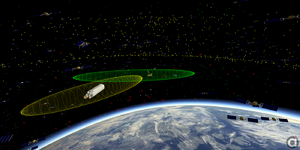Software:FreeFlyer
 3D Output of Proximity Zones representing Spacecraft Covariance, modeled in FreeFlyer | |
| Developer(s) | a.i. solutions, Inc. |
|---|---|
| Stable release | 7.8.1
/ May 2023 |
| Operating system | Windows, Linux |
| Platform | x86, x86-64 |
| Type | Technical computing |
| License | Proprietary commercial software |
| Website | ai-solutions |
FreeFlyer is a commercial off-the-shelf software application for satellite mission analysis, design and operations. FreeFlyer's architecture centers on its native scripting language, known as FreeForm Script. As a mission planning tool, it encompasses several capabilities, including precise orbit modeling, 2D and 3D visualization, sensor modeling, maneuver modeling, maneuver estimation, plotting, orbit determination, tracking data simulation, and space environment modeling.
FreeFlyer implements standard astrodynamics models such as the JGM-2, EGM-96, LP-165 gravity potential models; the Jacchia-Roberts, Harris-Priester, and NRL-MSIS atmospheric density models; the International Reference Ionosphere model; and the International Geomagnetic Reference Field magnetic field model.[1]
Background
a.i. solutions, Inc. is the owner and developer of FreeFlyer which has been in use since 1997. FreeFlyer is utilized by NASA, NOAA, and the USAF for space mission operations, mission assurance, and analysis support.[2][3][4][5][6][7]
Operational and analysis support
FreeFlyer has been used to support many spacecraft missions, for mission planning analysis, operational analysis, or both. Specific mission examples include the International Space Station (ISS),[8] the JSpOC Mission System,[9] the Earth Observing System,[10][11] Solar Dynamics Observatory (SDO),[12] and Magnetospheric Multiscale Mission (MMS).[13]
FreeFlyer has also been successfully used to conduct analysis in both the high-performance computing (HPC) and service-oriented architecture (SOA) environments.[14][15]
Software tiers
FreeFlyer is one stand-alone product with no added modules, though it does have two tiers of rising functionality.
| Engineer | Mission |
|---|---|
The Engineer tier includes:
|
The Mission tier includes all Engineer functionality, plus:
|
FreeFlyer scripting
The FreeFlyer Engineer and Mission tiers contain an integrated scripting language and development environment. The scripting language is an object-oriented script with objects and commands. Objects include properties and methods.
An example of FreeFlyer scripting is this:
// Create a spacecraft object Spacecraft sc1; // Create a ViewWindow, passing sc1 as part of an array of objects to view ViewWindow vw({sc1}); // Propagate and view the spacecraft for two days While (sc1.ElapsedTime < TimeSpan.FromDays(2)); sc1.Step(); vw.Update(); End;
References
- ↑ "FreeFlyer". January 2010. http://www.ai-solutions.com/freeflyer/. Retrieved March 26, 2010.
- ↑ "a.i. solutions To Lead Goddard Support Teams". October 2009. http://www.spacenews.com/contracts/solutions-lead-goddard-support-teams.html. Retrieved December 15, 2009.
- ↑ "NASA Selects a.i. solutions for $95M Flight Dynamics Support Services (FDSS) Contract". October 2009. http://www.spaceref.com/news/viewpr.html?pid=29308. Retrieved January 24, 2010.
- ↑ "Hadron/Analex Awarded $160 Million NASA Contract". May 2002. http://www.spaceref.com/news/viewpr.html?pid=8477. Retrieved January 20, 2010.
- ↑ Clabaugh, Jeff (October 2005). "Analex wins $65M Elvis contract extension". http://www.bizjournals.com/washington/stories/2005/10/03/daily2.html. Retrieved January 20, 2010.
- ↑ "Missile Defense Agency Engineering and Support Services (MiDAESS) Quality Safety and Mission Assurance (QSMA) Functional Capability Group". January 2010. https://www.fbodaily.com/archive/2010/01-January/24-Jan-2010/FBO-02048435.htm. Retrieved March 20, 2010.
- ↑ "ENGINEERING REVIEW INFORMATION SYSTEM US Patent 20080005122 a.i. solutions, Inc.". November 2008. http://www.freepatentsonline.com/y2008/0005122.html. Retrieved March 26, 2010.
- ↑ "Johnson Space Center Core Trajectory Subsystem Contract Award". December 2011. http://www.satnews.com/cgi-bin/story.cgi?number=2117338379. Retrieved December 12, 2011.
- ↑ "JMS Contract Award". January 2013. http://www.marketwired.com/press-release/ai-solutions-awarded-contract-provide-freeflyerr-software-dods-joint-space-operations-1746494.htm. Retrieved January 30, 2013.
- ↑ Matusow, Carla; Wiegand, Robert (1999). "Automated Flight Dynamics Product Generation for the EOS AM-1 Spacecraft". Spacecraft Ground Control and Data Systems (SCD 2).
- ↑ Close Approach Prediction Analysis of the Earth Science Constellation with the Fengyun-1C Debris, by Matthew Duncan and David Rand
- ↑ FedBizOpps
- ↑ "Apogee Raising Technique for the MMS Formation Flying Mission, by Craig Roberts, Jason Tichy, and Cheryl Gramling". http://www.ai-solutions.com/file.asp?F=A47ACEE6AC8845AF970F4B86643ADB38.pdf&N=Apogee+Raising+Technique+for+the+MMS+Formation+Flying+Mission.pdf&C=library.
- ↑ "Microsoft HPC Case Study". June 2001. http://www.microsoft.com/casestudies/Case_Study_Detail.aspx?casestudyid=4000003011. Retrieved March 26, 2010.
- ↑ "A Flexible Satellite Command and Control Framework". September 2009. http://www.aero.org/publications/crosslink/summer2009/04.html. Retrieved March 26, 2010.
- ↑ "Mathworks.com". 2008. http://www.mathworks.com/products/connections/product_detail/product_35478.html. Retrieved March 26, 2010.
External links
 |

